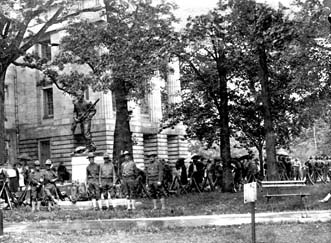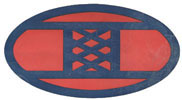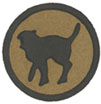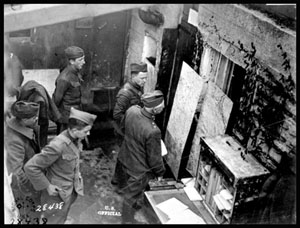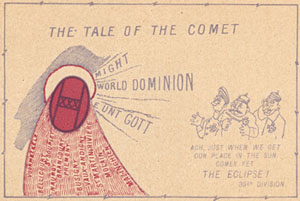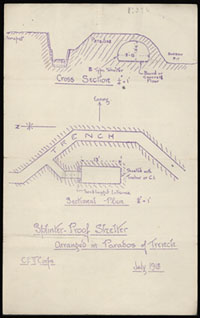 |
| Above:
"Plan for layout of small shelters," July 1918,
Ypres Front, Belgium, 105th Engineers Regiment,
30th Division. Joseph H. Pratt Papers.
Click on image for a
larger view. |
The 105th Regiment of Engineers served
in the 30th "Old Hickory" Division as a combat engineer
regiment. Over 75 percent of the soldiers in the 105th
claimed North Carolina as their home state. The regiment
trained at Camp Sevier, South Carolina, for eight months
before arriving in France in June 1918. The 105th
constructed trenches, shell- and splinter-proof
shelters, roads, bridges, buildings, forward water
stations, and miles upon miles of barbed wire. The
engineers often worked under artillery fire when
constructing defensive structures on the East and West
Poperighe Trench systems near Ypres, Belgium, near Mount
Kemmel, Belgium, the canal sector along the Belgium and
French border, and on the Hindenburg Line near
Bellicourt, France.
The engineers' duties also included
performing gas attacks, and the removal of explosive
"booby" traps and mines.
Gas Attack
The 105th Engineers launched several
gas attacks against the Germans. On August 26, 1918,
near Ypres, Belgium, fifty men from Company F and
several men from the 120th Infantry, 30th Division,
became victims of their own gas. Unfortunately for the
soldiers of the 30th Division, the wind did not
sufficiently carry the gas across the German lines and a
gas "backlash" encroached upon the American soldiers.
The soldiers had their gas masks ready, but the
combination of fear, panic, barbed wire, and German
machine-gun fire resulted in the death of three soldiers
in the 105th and twenty casualties in the 120th Infantry
Regiment. Read about the incident in the following
primary documents below.
 Gas
Attack of August 26th.
Click on the image to read the
document.
Gas
Attack of August 26th.
Click on the image to read the
document.
 Secret:
Report on Gas Attack.
Click on the image to read the
document.
Secret:
Report on Gas Attack.
Click on the image to read the
document.
"Booby Traps"
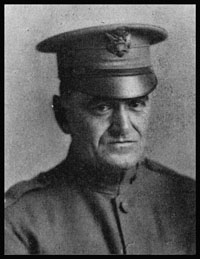 |
|
Above: Col.
Joseph Hyde Pratt, 105th Engineers, 30th
Division. |
Removing booby traps and mines left
behind by enemy troops proved to be one of the 105th
Engineers' most dangerous responsibilities. Booby traps
are explosive devices that are hidden or disguised bombs
that detonate when activated by pressure or movement.
These devices could be activated in various ways, such
as stepping on a pressure trigger, or by moving a
shovel, book, or helmet that soldiers wanted for
souvenirs.
Colonel Pratt, 105th Engineers, 30th
Division, wrote in his diary about the clever traps left
by the Germans:
"We are constantly on the lookout for
mines and Booby Traps. The Hun is very ingenious and
nothing is too devilish for him. This past summer when
he withdrew from a certain place, he left a pond that
had all the appearance of having been used as a swimming
place, even had a spring [diving] board in place. A
party of Australians came to the pond and got ready to
go swimming. The first two dove in but did not come up.
Their companions went in after them and found they had
been spiked. The Germans had placed upright spikes in
the bottom of the swimming pool. A party of our men
started to bury a German; as they lifted the body an
explosion took place and two of our men were killed.
They had used the body to make a "booby trap." We do not
bury German dead except on the battlefield, and then
only after testing them. The German apparently does
everything that will make the rest of the world hate him
and desire his destruction." -October 10, 1918. Diary of
Col. Joseph Hyde Pratt, page 185.
On October 18, 1918, Colonel Pratt
wrote in his diary about another booby trap:
"Today A Company, which was working on
the mines and Booby traps, found what was thought to be
a mine in the church at St. Martin Reviere. Captain
Brooks, who was in charge of the work, took out 300
pounds of Perdite from the church steeple. It was
afterwards discovered that this charge of explosive was
connected by wires and explosive caps with the front
part of the church, and so arranged that when anybody
knelt at the altar the Perdite would be exploded. This
is one of the most malicious Booby traps we have found."
-Diary of Col. Joseph Hyde Pratt, page 193.
To learn what Colonel Pratt
meant by "Hun" go to the
Index.
To learn more about "Booby
Traps" read the army intelligence reports below:
 "Summary
of Intelligence, September 21 to September 27, 1918."
Click on the
image to read the document.
"Summary
of Intelligence, September 21 to September 27, 1918."
Click on the
image to read the document.
 "German Traps and Mines,"
Circular No. 4.
Click on the image to read the document.
"German Traps and Mines,"
Circular No. 4.
Click on the image to read the document.
